A compound inequality can express a range of values, which is useful to indicate uncertainty (such as when making estimates or projections). However, there are two basic types of compound inequalities to be aware of.
So, what is a compound inequality? A compound inequality is a combination of two or more inequality statements, which are joined (compounded) by “AND” or “OR”. The solutions of an “AND” compound inequality satisfy both (all) inequality statements. The solutions of an “OR” compound inequality satisfy at least one inequality statement.
In some cases, a compound inequality can have no solution at all. In other cases, a compound inequality can have a solution of all real numbers.
In this article, we’ll talk about compound inequalities, what they are, and how to solve them. We’ll look at some examples and answer some common questions as well.
Let’s get started.
What Is A Compound Inequality?
A compound inequality is a combination of two or more inequality statements taken together. These two inequality statements are joined (or compounded) by one of two conjunction words:
- “AND” – this word means “intersection”. The solutions of an “AND” compound inequality must satisfy all of the inequality statements.
- “OR” – this word means “at least one” (one, or the other, or both/all)”. The solutions of an “OR” compound inequality must satisfy at least one of the inequality statements.
Sometimes, a compound inequality will have no solution at all. In other cases, a compound inequality will have a solution of all real numbers (we will see examples of both cases later in this article).
What Does A Compound Inequality Represent?
A compound inequality represents a set of numbers (one or more intervals on a number line). Often, these intervals cannot be expressed by a single inequality statement alone.
So, compound inequalities give us notation that allows us to express more sets and intervals. Let’s take a look at some of those compound inequalities now, along with their graphs.
Compound Inequality Graphs
We use a number line to draw the graph of a compound inequality in one variable as follows:
- We use circles at the endpoints of any intervals in the set of solutions
- We shade the parts of the line that are included in the set of solutions
Remember that the circles at the endpoints of an interval come in two types:
- Open circles, used for strict inequality symbols, such as < and >. An open circle means that the endpoint at the circle is excluded from the set of solutions.
- Closed circles, used for inclusive inequality symbols, such as <= and >=. A closed circle means that the endpoint at the circle is included in the set of solutions.
Example 1: Graph Of The Compound Inequality x > 3 OR x < 2
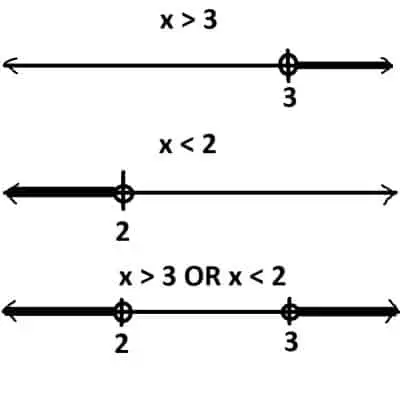
Example 2: Graph Of The Compound Inequality x >= 4 OR x >= 5
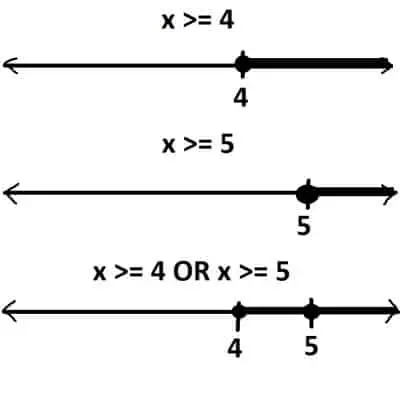
Example 3: Graph Of The Compound Inequality x <= 4 AND x >= 2
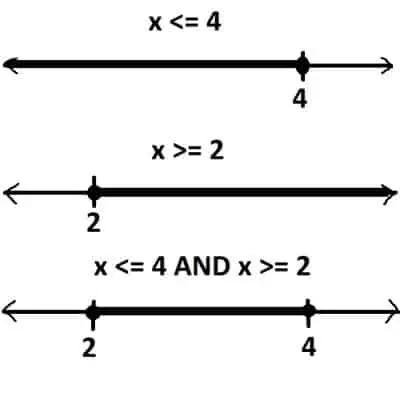
Example 4: Graph Of The Compound Inequality x > 5 AND x < -3
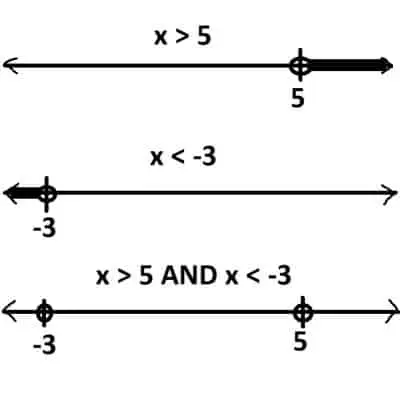
How To Solve A Compound Inequality
To solve a compound inequality in one variable, we must isolate the variable on one side of the inequality, and then solve for that variable.
This will involve the use of addition/subtraction and multiplication/division. Remember that there is a key rule when working to solve an inequality:
- If you multiply or divide both sides of an inequality by a negative number, you must reverse the direction of the inequality symbol.
For example, to solve the inequality -2x > 6, we divide by -2. After reversing the direction of the inequality symbol, we get:
- -2x > 6
- -2x/-2 < 6/-2
- x < -3
Now let’s look at some examples of how to solve compound inequalities.
Example 1: Solving An “OR” Compound Inequality
Let’s say we want to solve the compound inequality 2x > 12 OR -3x + 6 < 21.
For the first inequality, we simply divide by 2 on both sides to get x > 6.
For the second inequality, we need to subtract 6 and then divide by -3, as follows:
- -3x + 6 < 21
- -3x < 15
- x > -5
So, the solution to the compound inequality is the set of numbers where at least one of the statements x > 6 or x > -5 are true.
This would be the set of numbers x > -5. We can see the graph of this set below.
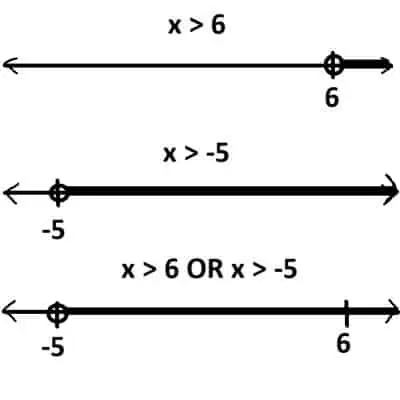
Example 2: Solving An “OR” Compound Inequality
Let’s say we want to solve the compound inequality 5x < 20 OR 4x + 8 > 24.
For the first inequality, we simply divide by 5 on both sides to get x < 4.
For the second inequality, we need to subtract 8 and then divide by 4, as follows:
- 4x + 8 > 24
- 4x > 16
- x > 4
So, the solution to the compound inequality is the set of numbers where at least one of the statements x < 4 or x > 4 is true.
This would be the set of numbers where x is not equal to 4 (that is, all real numbers except x = 4). We can see the graph of this set below.
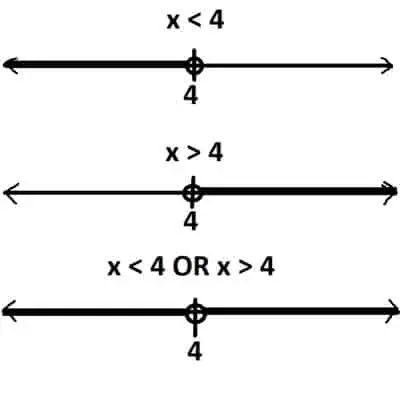
Example 3: Solving An “AND” Compound Inequality
Let’s say we want to solve the compound inequality 2x > 12 AND -3x + 6 < 21.
For the first inequality, we simply divide by 2 on both sides to get x > 6.
For the second inequality, we need to subtract 6 and then divide by -3, as follows:
- -3x + 6 < 21
- -3x < 15
- x > -5
So, the solution to the compound inequality is the set of numbers where both of the statements x > 6 and x > -5 are true.
This would be the set of numbers x > 6 (the numbers greater than -5, but less than or equal to 6 satisfy one inequality, but not both). We can see the graph of this set below.
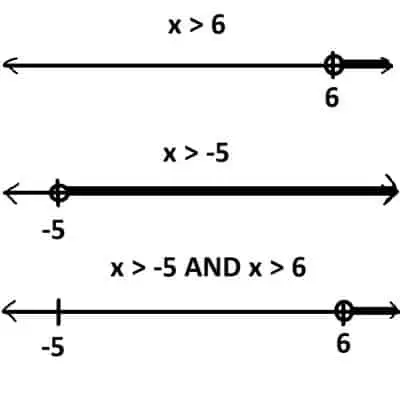
Example 4: Solving An “AND” Compound Inequality
Let’s say we want to solve the compound inequality 5x <= 20 OR 4x + 8 >= 24.
For the first inequality, we simply divide by 5 on both sides to get x <= 4.
For the second inequality, we need to subtract 8 and then divide by 4, as follows:
- 4x + 8 >= 24
- 4x >= 16
- x >= 4
So, the solution to the compound inequality is the set of numbers where both of the statements x <= 4 and x >= 4 are true.
This would be just the number 4 (that is, the set {4}). We can see the graph of this set below.
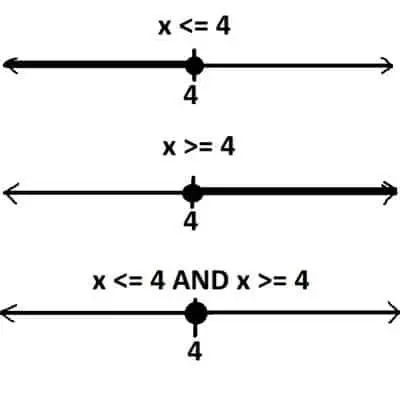
Is An Absolute Value Inequality A Compound Inequality?
We can always write an absolute value inequality as a compound inequality. This is because an absolute value inequality has two “halves”: one for the positive part of the solution, and one for the negative part of the solution.
Each part of the solution corresponds to one of the inequality statements in a compound inequality.
Example 1: Writing An Absolute Value Inequality As A Compound Inequality
Let’s say we want to convert the absolute value inequality |2x + 3| < 15 to a compound inequality.
First, remember that there are two halves to the solution set for this inequality: the chain of inequalities
- -15 < 2x + 3 < 15
which we can also express as the compound inequality
- 2x + 3 < 15 AND 2x + 3 > -15
As a shortcut, we can solve the chain of inequalities as follows:
- -15 < 2x + 3 < 15
- –15 – 3 < 2x + 3 – 3 < 15 – 3
- –18 < 2x < 12
- -18/2 < 2x/2 < 12/2
- -9 < x < 6
We can express this chain of inequalities as the compound inequality x < 6 AND x > -9.
Example 2: Writing An Absolute Value Inequality As A Compound Inequality
Let’s say we want to convert the absolute value inequality |4x + 6| > 14 to a compound inequality.
First, remember that there are two halves to the solution set for this inequality:
- 4x + 6 > 14 OR 4x + 6 < -14
We can solve the first inequality as follows:
- 4x + 6 > 14
- 4x > 8
- x > 2
We can solve the second inequality as follows:
- 4x + 6 < -14
- 4x < -20
- x < -5
We can express this set as the compound inequality x > 2 OR x < -5.
Can A Solution Of A Compound Inequality Be All Real Numbers?
The solution of a compound inequality can be the set of all real numbers in some cases. Here are two such cases.
Example 1: A Compound Inequality With A Solution Of All Real Numbers (“OR”)
Consider the compound inequality x > 2 OR x < 3. The set of solutions includes every number that satisfies at least one of those inequalities.
All numbers to the right of 2 on the number line satisfy the first inequality. All numbers to the left of 3 on the number line satisfy the second inequality.
So, every real number satisfies at least one of the inequalities (the numbers between 2 and 3 satisfy both inequalities).
Example 2: A Compound Inequality With A Solution Of All Real Numbers (Absolute Value)
Consider the absolute value inequality |x – 2| >= 0.
Since an absolute value is always zero or positive, we know that every real number will satisfy this inequality.
We can also see this by splitting the absolute value inequality into two parts to get the compound inequality:
- x – 2 >= 0 OR x – 2 <= 0
- x >= 2 OR x <= 2
This is the set of all real numbers.
Can A Compound Inequality Have No Solution?
A compound inequality can have no solution, but it requires an AND under certain conditions (or an absolute value inequality).
Example 1: A Compound Inequality With No Solution (“AND”)
Consider the compound inequality x > 3 AND x < 3.
There is no number that is both greater than 3 and less than 3 (not even the number 3 satisfies both inequality statements).
Thus, there is no solution to this compound inequality.
Example 2: A Compound Inequality With No Solution (Absolute Value)
Consider the absolute value inequality |x| < 0.
Since an absolute value is always zero or positive, it can never be negative.
So, |x| can never be less than 0. Thus, there is no solution to this absolute value inequality.
Conclusion
Now you know what a compound inequality is and also how to solve one. You also know the answers to some common questions about this useful concept.
You can learn about the uses of inequalities in everyday life here.
You might also want to read up on how to solve and graph quadratic inequalities.
I hope you found this article helpful. If so, please share it with someone who can use the information.
Don’t forget to subscribe to our YouTube channel & get updates on new math videos!



